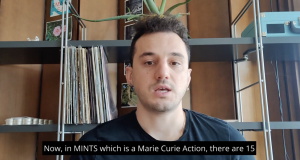Published on: Oct 16, 2020
First and foremost, Welcome! This is the first of many upcoming blog posts which will introduce us, the MINTS team, and our field of interests. This particular series, MINTS 101, will cover the general idea behind the project we are working on.
Who are we?
MIllimeter-wave NeTworking and Sensing for beyond 5G, or as it is abbreviated, MINTS is the consortium funded by the European Commission as a part of the EU Horizon 2020 initiative. We, 15 Early Stage Researchers (ESRs) working in 8 beneficiaries together with 6 partner organizations, aim to overcome the challenges of mmWave (millimeter-wave technology) and enable the development of the next-generation wireless networks. Each one of us is enthusiastic about our topic and we are all committed to seeing it through to the end of the PhD, as this is only the beginning of our journey.
P.S: In our future blogs, there will be many chances to get to know us, the MINTS ESRs. But for now, let’s move on to our main dish.
What is mmWave?
The radio spectrum (the band dedicated to antenna transmissions) ranges from 3 Hz – 3000 GHz and is divided into different bands,each dedicated to different services. Of that, the super high-frequency band from 30-300 GHz is where mmWave transmission takes place. It is known as mmWave because it has a wavelength that lies in the millimeter range (i.e., λ = c/f). Even though what is being offered in terms of bandwidth is promising, there are noticeable differences in propagation characteristics when compared with lower frequency waves.

Figure 1. 5G mmWave spectrum range (Source: QUALCOMM)
Signals at millimeter-wave frequency suffer from high path loss, which limits their range. Specifically, there are high diffraction and penetration losses, which increase the importance of the reflected and scattered signals. To cope with these communication challenges, a technique called beamforming is used. Beamforming is a signal processing procedure used with multiple arrays of antennas at the transmitter side and/or receiver side to simultaneously send or detect multiple signals from multiple desired terminals to increase system capacity and performance [1]. This is thanks to the small wavelength of the signal. As a result, mmWave has a large bandwidth, low interference, small component size, cost-efficiency communication link, and the ability to detect more objects in an area. Due to these advantages, nowadays, it is finding its use in commercial applications. It is already in 5G standards and is being used in many areas such as radar systems [2]. So, let’s see what is being currently studied and what has been done with this technology.
Where is mmWave used?
In telecommunication, bands between 71 and 95 GHz are used for establishing point-to-point high-bandwidth communication links. At this frequency range, waves do not undergo atmospheric absorption. In the United States, there are plans to deliver 10 Gbit/s links using these bands [3]. Usage of mmWave bands with point-to-point communication is slowly emerging in 5G mobile phones [4]. In addition, making vehicles communicate with each other is one of the hot topics within mmWave [5]. IEEE 802.11ad WiFi standard, which is meant for static scenarios with a transmission rate of multiple gigabits, is also in the 60 GHz band. However, it is prone to obstacles and the communication range is rather limited.

Figure 2. mmWave Applications and Use-cases (Source: ETSI)
Radio astronomy is another area that operates in the mmWave frequency band. For instance, satellite-based remote sensors around 60 GHz are used for computing the radiation emitted from oxygen molecules which in return yields the temperature around the upper atmosphere.
The importance of detecting dangerous objects such as weapons is an important security measure for shopping malls or airports. mmWaves of some frequency can penetrate through organic materials such as cotton that are used for clothing. Due to the relatively long-range of mmWave security scanners compared to traditional scanners, a circular area of 50 meters radius can be scanned for those malicious objects that could otherwise be hidden within the clothing of a person [6].
Application areas of mmWave go from telecommunication to speed radars and medical diagnostic tools. Due to its capacity and the vast amount of available bandwidth, there is a huge potential for exploitation. This is particularly why fields such as 5G, vehicular communication, or remote sensing, are attracting more and more researchers.
If you were able to stick until the end and can’t wait for more content and you also want to know about us and our projects, you can always follow our social media channels.
Citations
[1] Ali, E., Ismail, M., Nordin, R. et al. Beamforming techniques for massive MIMO systems in 5G: overview, classification, and trends for future research. Frontiers Inf Technol Electronic Eng 18, 753–772 (2017). https://doi.org/10.1631/FITEE.1601817
[2] “28775-is-millimeter-wave-technology-future-of-wireless-communications @ www.microwavejournal.com.” [Online]. Available: https://www.microwavejournal.com/blogs/25-5g/post/28775-is-millimeter-wave-technology-future-of-wireless-communications#:~:text=With several advantages of millimeter,are finding use in several.
[3] J. Wells, “Multigigabit wireless technology at 70 GHz, 80 GHz and 90 GHz,” RF Des., pp. 50–58, 2006.
[4] T. E. Bogale, X. Wang, and L. B. Le, “Chapter 9 – mmWave communication enabling techniques for 5G wireless systems: A link level perspective,” S. Mumtaz, J. Rodriguez, and L. B. T. M. M. Dai, Eds. Academic Press, 2017, pp. 195–225.
[5] A. Asadi, S. Müller, G. H. Sim, A. Klein, and M. Hollick, “FML: Fast machine learning for 5G mmWave vehicular communications,” in IEEE Conference on Computer Communications (INFOCOM), 2018, pp. 1961–1969.
[6] “Bat_inspires_space_tech_for_airport_security @ www.esa.int.” [Online]. Available: http://www.esa.int/Space_in_Member_States/Ireland/Bat_inspires_space_tech_for_airport_security.





